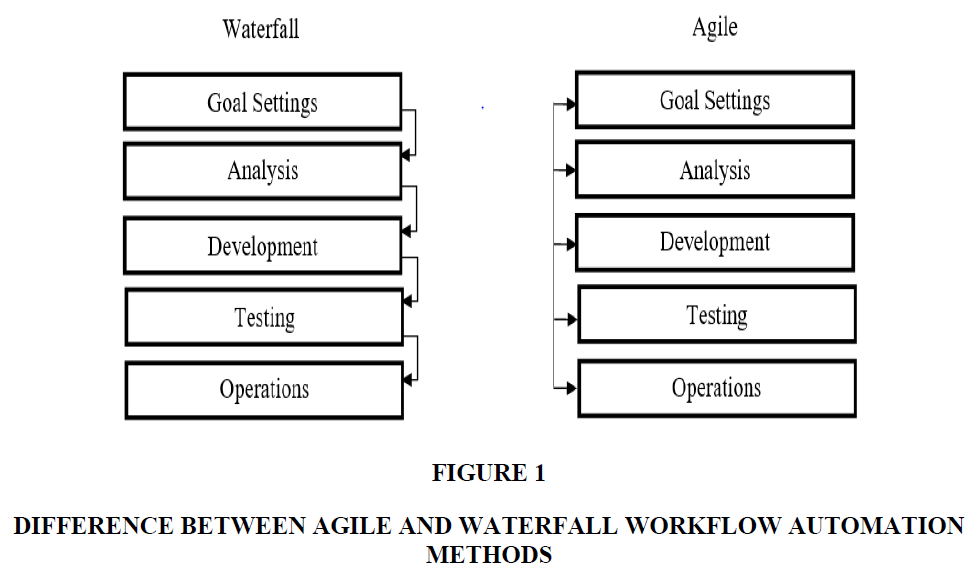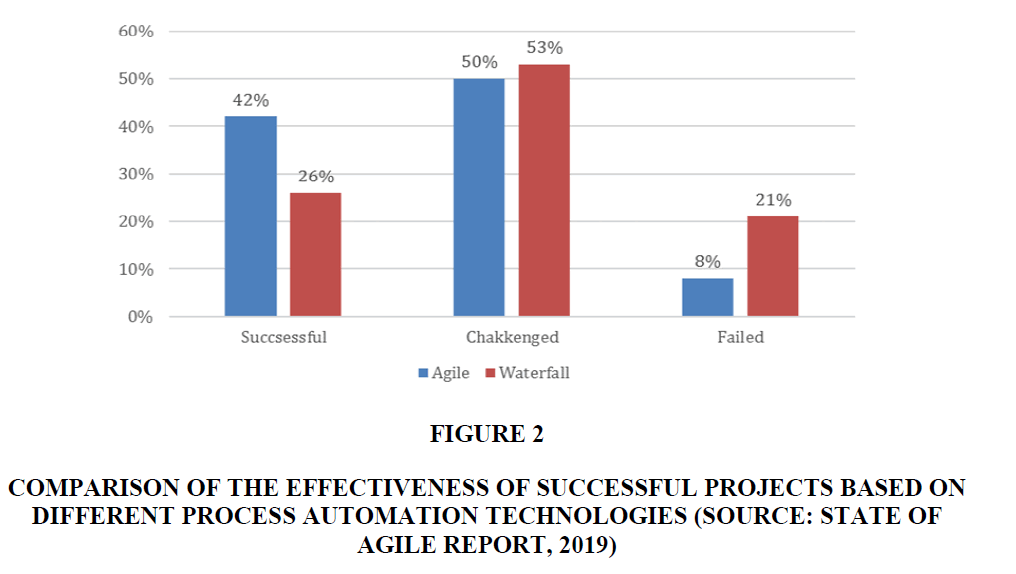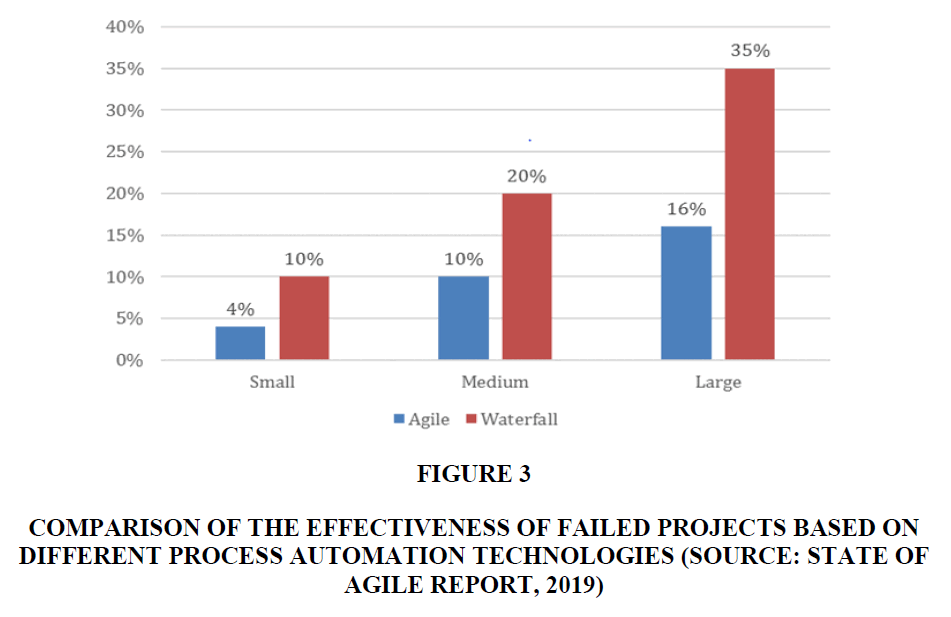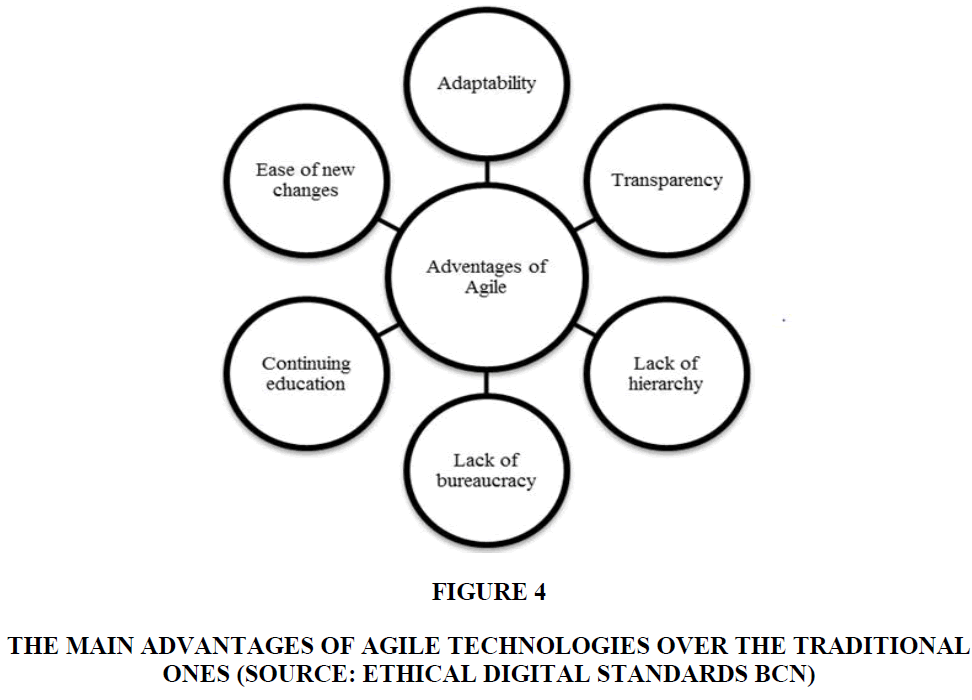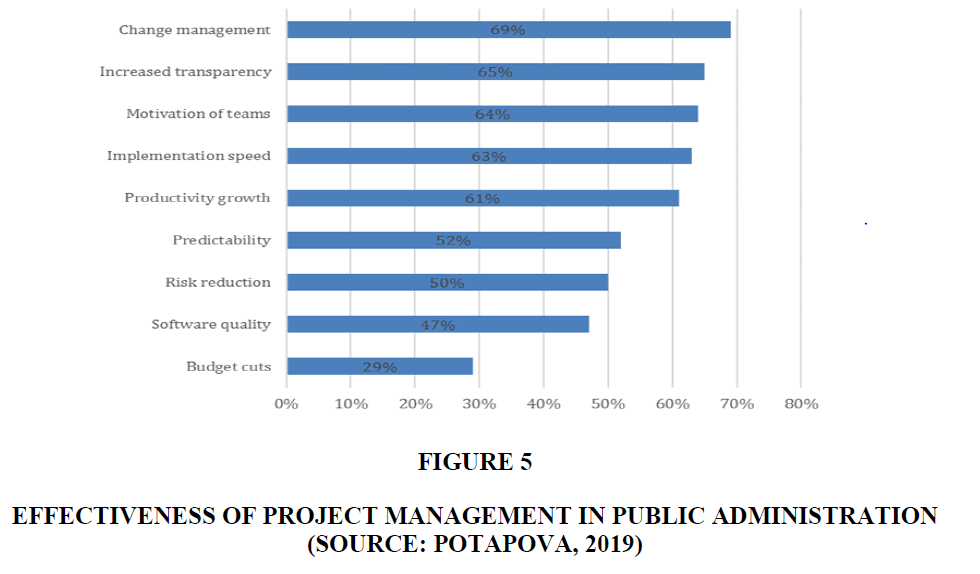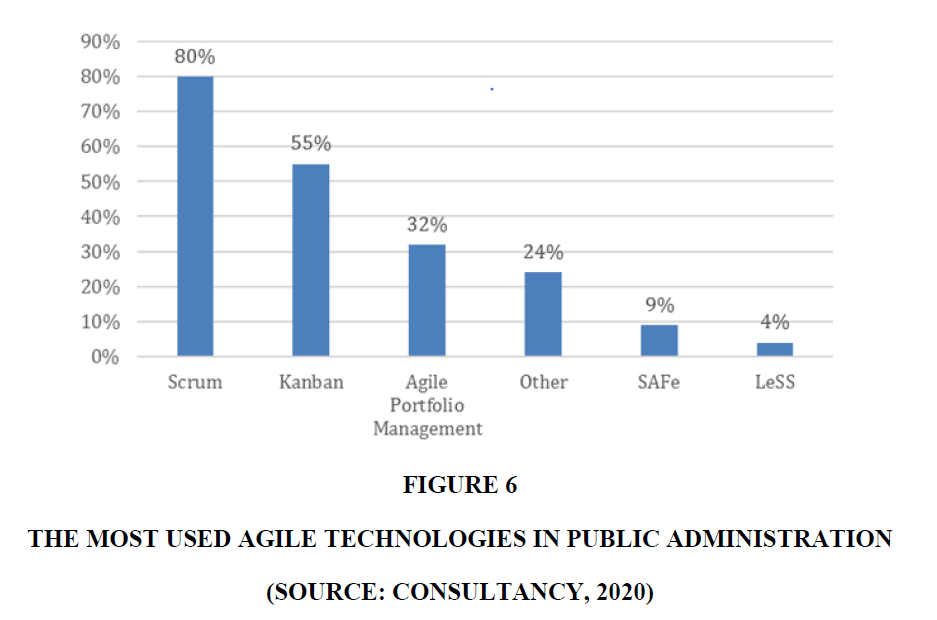Research Article: 2020 Vol: 23 Issue: 5
Project Management Technologies in Public Administration
Olena Aleinikova, University of Educational Management
Sergey Kravchenko, Donetsk National Technical University
Viktoriya Нurochkina, University of the State Fiscal Service of Ukraine
Viktor Zvonar, Borys Grinchenko Kyiv University
Oleksandr Brechko, Western Ukrainian National University
Zoriana Buryk, Vasyl Stefanyk Precarpathian National University
Citation Information: Aleinikova, O., Kravchenko, S., Нurochkina, V., Zvonar, V., Brechko, O., & Buryk, Z. (2020). Project management technologies in public administration. Journal of management Information and Decision Sciences, 23(5), 564-576.
Abstract
The article discusses project management technologies in public administration. Two technologies were used for the purpose of comparison. The first one is classic based on Waterfall, i.e. a consecutive method of developing projects. The second technology is flexible, suitable for integrated project development and based on agile approach. The study analyzes the scientific papers determining the need for agile technology not only in business processes and the IT industry, but in public administration as well. Both successful and failed experience of introducing automation of management in the developed countries is investigated. The main problems related to the use of agile technologies in public administration are defined. The main advantages and disadvantages of using this technology compared to the classical one are considered. The paper defines the concept of agile technology in public administration, as well as its types, which are most frequently used to organize the development of government projects.
Keywords
Public Administration; Project Management; Waterfall; Agile; Scrum.
Introduction
In terms of information society, modern public administration can’t do without the introduction of digital technologies. For the governments of many countries nowadays, a top priority is the creation of electronic services aimed at effective management as well as the promotion of bilateral relations between citizens and government. This is especially true for developing countries that perform the transition to digital technologies (USGAO, 2012; HUD, 2018). However, as practice shows, not all electronic systems of public administration have become successful. Moreover, there is a substantial portion of failed projects that only complicate documentation management and create even more problems, since the significant part of the population is not ready to accept the introduced ways of obtaining public services (Anthopoulos et al., 2016). Public officials who got used to working in traditional ways also experience various difficulties because they can’t easily switch to modern systems of public project management.
Presently, the Waterfall method is used to implement the majority of projects in public administration all around the globe (Weisert, 2003). The Waterfall method or a cascade method of management was first introduced in 1956. Its essence is the sequential performance of step-by-step tasks, which leads to a certain general result. This is a classic way of managing new projects, which is essential not only for the government bodies, but for most businesses as well.
However, innovative technologies of project management offer new methods that allow to save resources as well as the project’s budget. In 2001, a new philosophy was introduced (Beck et al., 2001) along with a technology that abandons a step-by-step implementation of tasks. The classic cascade technology has been replaced by agile technology, the essence of which is the complex performance of all tasks from the simplest form to the most complicated one. This method is difficult in terms of implementation in public administration, since it requires an immediate involvement of all possible project development specialists. Agile philosophy puts a strong emphasis on the teamwork, with each participant contributing to the desired result during the process of project’s design. However, despite the difficulties of adapting the management method and relevant digital technologies to public administration needs, the flexible design methodology is more progressive compared to the cascade one, which will be proven in this study.
Business processes in the commercial area, in particular IT, focus on the use of new flexible technologies that allow to respond quickly to the problems, errors and changes in customer requests immediately after the implementation of the first and the simplest project model. Using the cascade form in public administration, it often happens that long before the complex of software automation is developed, it becomes obsolete, and a timely adjustment of the system, namely its software, becomes literally impossible, because the budget for program development is fully used. (Mergel, 2016; Project Management Institute, 2017).
Thus, the main purpose of this study is to explore the possibility of improving the automation of workflow in public administration by means of using flexible technologies. The main task of the study is to clarify the use of agile technologies concept and the possibility of its integration with the other established systems of automation of public administration (Greve et al., 2019).
Literature Review
Agile manifesto, 2001 was the first document defining the levels of process design using agile technology. Over the past 20 years, the use of agile technology in public administration has been studied by many scientists including Torrecilla-Salinas et al. (2013), who described the experience of using technology in Andaluсia (Spain). Mergel et al. (2020) also proved the importance of this technology in public administration. Since 2015, many scientific papers claim that promoting digital services in public administration, one needs to use innovative methods, in particular, agile technologies (Bertot et al., 2016; Blasc et al., 2016).
The introduction of agile technology in government agencies of the developed countries resulted in a considerable success. Based on this experience, government organizations throughout the world regard the name "Agile" as a tool to achieve the goals of public administration. Nowadays, the use of agile technologies significantly reduces the level of bureaucracy, which in turn contributes to the development of entrepreneurship as well as the establishment of more trusting and tight relations between the government and the citizens. Governments of the developed countries are changing their management methods in favor of the flexible agile technologies. These technologies are actively used in public procurement, organization of educational processes, etc. Their main strength is the ability to respond quickly to the environmental changes, which then occur without major modernization processes and high financial costs (Wise, 2006; Janssen & van der Voort, 2016).
The advantages of the flexible method are described by Mergel et al. (2020) in their study "Agile: A New Way of Governing". These authors are convinced that agile is the technology of a quiet government transformation, which requires significant funds, but instead allows to create software products that are flexible when it comes to solving government problems.
Greve (2019) in his study notes that if the public administration performs tasks using agile technologies, such approach not only helps create a useful product for society, but also builds an effective government structure that fosters making effective decisions.
Methodology
This paper makes use of a set of general scientific and special research methods. General scientific and special methods have been used to study methods of automation processes in public administration. Structural and functional methods are used to study different approaches to solving problems in public administration and to identify common and distinctive features between them. Methods of the system and comparative analysis were used in considering the researches and existing technologies in solving problems related to the organization of automated processes in public administration.
Synthesis is used to summarize information about the general properties of agile technology and its place in the development of public administration. Statistical analysis is used to determine the effectiveness of the use of software for process automation. Survey and observation techniques are used to study the efficiency of processes.
Results and Discussion
Nowadays, the United States mainly use relatively advanced automation systems based on flexible methods of information processing. For example, the Digital Service of the United States, the Digital Service of the United Kingdom and the Canadian Digital Service operate very successfully. Outlining the successful programs aimed at improving automation tools, it’s worth mentioning Finland, which developed a software for managing drivers’ licenses. Andalucia has developed two projects for the Ministry of Culture and Sports named eBOJA and TOPOS. A healthcare website in the USA was developed according to agile principles, as well as some projects of the US Ministry of Defense. The United Kingdom created an agency for drivers and transport standards to manage contracts. Spain also has substantial experience in implementing these technologies to improve management infrastructure (Agile Practice in Public Administration, 2018).
Let’s consider the successful cases of integration of agile technologies in public administration in more detail.
In the United States, about 80% of all government projects make the fullest use of agile technology, although so far its use is not regulated by law (Viller, 2018). The US Ministry of Defense was one of the early adopters using this technology for its projects. The technology is introduced by a team of the US Digital Service experts, involved in the development, implementation and training of civil servants.
The main activity of Digital Service includes:
• Development of websites and electronic applications for rendering public services;
• Development of recommendations by TechFar Technical Handbook on how to use flexible technologies in public administration;
• Creation of the TechFAR Hub aimed at the exchange of experience between the state agencies which already carry out purchases under new rules and the organizations which only intend to introduce flexible technologies;
• Arranging civil servants training (Digital Services Playbook).
Apart from this, the General Services Administration is engaged in optimizing production processes in order to develop the most perfect budgets.
In 2011, the United Kingdom successfully built a system of process automation in government agencies. Agile technologies were used in product development (National Audit Office, 2012). This technology was chosen based on its efficiency. First of all, the changes have taken place in the organizational culture. In order to introduce the service to the civil servants, several project teams were created. Scrum, Lean, Dynamic System Development Method (DSDM) were among the methods that were the most suitable for each organization to create a finished product. When installing the software, appropriate trainings were performed. As a result of the technology introduction, a set of solutions was implemented. They clearly demonstrated that new employees adapted to modern systems much faster than those who were accustomed to perform their work in traditional ways. At the same time, teamwork was the main problem during the development of these technologies, since one part of the team was engaged in the development of algorithms, while the other designed an interface, so misunderstanding frequently appeared. That’s why in order to organize the digitalization of public services, the Digital Service Standard was created, which is still used today. Its main goal is to use common platforms and standards, such as cloud, government cloud and open cloud. Testing was the cornerstone of the standard, which allowed to improve the software so that it was convenient for all users.
Australia is another successful example of the country that actively uses flexible approaches to public project management. As a result, it has become one of the world's leading digital economies. Involvement of highly qualified specialists in the development of government projects is the main factor contributing to the improvement of the country's competitiveness on the global scale. The nationwide digital transformation strategy aims at making Australia one of the leading digital countries by 2025 (ACS, 2018).
The main purposes of this project are to introduce a strategy for the development of the digital economy in Australia until 2025, the implementation of public digital platforms on investments, politics, public confidence, and public control over the portfolio of information and communication technologies and investments in digital technologies. The state has already created a number of standards that are used to improve processes in public administration.
All flexible processes of developing automated public services pass the following four stages: Discovery, Alfa, Beta, Live. The same stages took place in the UK. At each of these stages, all government projects conducted in accordance with the developed standards are subject to the mandatory evaluation in order to ensure the transparency of project management, as well as understanding of the achieved results and supporting the teams of government organizations in the process of developing services. The developer of automation systems provides free support to the government officials, which includes arranging training seminars and various workshops on digital services for civil servants, helps with the purchase of digital products and advises on investments in digital technologies.
In general, we can say that workflow modernization programs are successful, but difficult for government agencies, because they do not have enough financial and human resources to implement. Still, the use of such systems allowed to develop a plan for the system automation and make adjustments in the process of its implementation in accordance with the results and the emergence of new, more rational goals. This method of modernization can be compared to learning, when development teams improve their skills in the process of their work. Such technology represents an alternative to the cascade or waterfall method, which is more commonly used to develop automated processes.
Modern textbooks on project management identify a number of the most common approaches to management, which are used depending on the project life cycle. Most of them are based on the classical approaches (Mergel, 2016):
• Intellectual (cascade, waterfall) approach is based on one-time planning and implementation;
• Iterative approach allows to receive feedback at the early stages of the project to finalize the product;
• Incremental approach means the delivery of the product in small parts as they get ready (Figure 1).
Flexible technologies that combine interactive and incremental approaches stand separately. They differ from the traditional cascade methods of project implementation. According to the cascade methods, the project is implemented stage by stage, and, as a rule, if the previous stage is not completed, the team does not proceed to the next one. The project begins with the substantiation of the project idea, collection of requirements, detailed design, after this comes implementation and verification and the final stage involves the acceptance of the results by the customers and completion of the project. It frequently happens that only at the final stage it is possible to get a feedback from the ultimate users and understand what was done right and what a mistake was. Of course, the developers within a cascade project can provide testing of the product at different stages too, but, unlike flexible approaches, they have fewer opportunities to change the product based on the results of testing. All this does not reduce the importance and effectiveness of the traditional methods of project management, but only suggests that flexible approaches will be more reasonable and beneficial for a certain number of projects.
Agile technology is a way of thinking that allows to make changes in both team and administrative management of the organization. This technology was developed for the purpose of the reforms, which solve the needs of society while adapting to the changes in environment. The technology allows to build a more efficient system of public administration. Let’s consider its main advantages.
Within the framework of agile technology, all its stages like setting the goals, analysis, development, checking the results pass in each short iteration. With such approach to management, the first results appear very quickly. It may be just a prototype of the final product, but its availability allows to get the necessary feedback from the users, clarify the understanding of the desired result and adjust plans. The results of the project are finalized interactively to reach the required level.
Comparisons of the cascade method of management with Agile during 2013-2017 showed that more successful projects use Agile. In particular, Figure 2 shows the difference between successful projects launches using different project management technologies.
Figure 2 Comparison of the Effectiveness of Successful Projects Based on Different Process Automation Technologies (Source: State of Agile Report, 2019)
At any respect, Agile differs significantly from the traditional project management approach. As for the failures, the situation is also in favor of Agile. The gap between traditional management technologies and agile technologies is more than 2 times, which is described in Figure 3.
Figure 3 Comparison of the Effectiveness of Failed Projects Based on Different Process Automation Technologies (Source: State of Agile Report, 2019)
In order to have a more profound understanding of the difference between these methods of developing automation systems, let’s make a comparative Table 1.
| Table 1 The Main Differences Between Agile and Waterfall Automation Systems | ||
| Agile | Waterfall | |
| Essence | Flexible model of development based on iterative principles | Cascade system of development based on a rigid sequence of stages |
| Date of creation | 2001 | 1956, 1961, 1970 |
| Developers | Group of IT specialists (USA) | G. Bennington, Hozier, W. Walker Royce |
| Principles of application | • Meeting the customer needs is the highest priority; • Viable product is the main indicator of progress; • Work can be entrusted only to a self-organized and motivated team; • Optimal period of product release: from 2 weeks to 2 months; |
• Rigid sequence of development stages; • Transition to a new stage occurs only after the successful completion of the previous one; • Fixed cost of the product; • The customer is not directly involved in the development process; • Changes can only be made after the entire development process is completed. |
| Main problems | • Risk of endless product changes; • High dependence on the level of qualification and experience of the team; • It is almost impossible to calculate precisely the total cost of the project. |
• Priority of a formal approach to the sequence of the work process; • Impossibility for the customer to make changes before the end of product development; • In case of resources shortage, the project’s quality suffers due to the shortened testing phase. |
However, the research concerns the use of these methods not in public administration. Given that agile technology was developed in the early 2000s, its use in public administration can be considered rather slow. However, the experience of using agile technology in various countries allows to determine its main advantages for public administration (Figure 4).
Figure 4 The Main Advantages of Agile Technologies over the Traditional Ones (Source: Ethical Digital Standards BCN)
Adaptation to the environment. Agile suggests that the market environment and demands of society may change over time. New information and opportunities that arise in the current conditions make developers to review and update the previous version of the program to improve the processes and services. As long as traditional result-oriented processes do not use flexible methods of implementing changes, it will be impossible to create the right product that will meet the needs of society.
Transparency of changes. Transparency in the development of the management system is improving because the users of information know who made the changes and why these changes occurred.
Rejection of the hierarchical structure. Agile prefers an adaptive structure over hierarchies and elevators. Unlike traditional systems, which have a clear administrative division, flexible technologies can be used to implement cross-functional measures.
Refusal of bureaucratic procedures. Agile allows to almost completely get rid of bureaucratic procedures and problems. Instead of following traditional standard procedures, the employees who have switched to the flexible systems solve the problems more efficiently. These systems provide more flexibility when it comes to the requests of public administration participants and respond quickly to them.
Continuous learning. Agile accepts possible errors and failures that may occur in the first versions, which finally leads to the improved management processes. Public managers must abandon the rule of absence of errors in work, because these errors allow to develop and create a better environment. Agile motivates to learn from the mistakes.
Introduction of new services. Agile increases knowledge about the processes and procedures of creating new services. If any new services that need to be adapted to the existing ones emerge, this can be done by means of flexible technologies which will eventually bring new knowledge to the system (Mergel et al., 2020).
Figure 5 specifies the strongest aspects of agile technology. They include the possibility of rapid changes, transparency of development, team motivation, speed of project implementation, etc. It is important to note that such process automation methods allow to reduce budgets by 29%.
When it comes to the choice of agile methodology, a user can opt between more than ten widely used agile methodologies. Although they all share common agile values, each has its unique peculiarities. Scrum is most frequently used in public administration, as shown in Figure 6.
According to its creators, Scrum is a framework that helps to solve tasks that change in the process of work to design products productively and creatively with the maximum possible value. Scrum is compact and easy to understand, but it’s quite difficult to become a real Scrum master (The Scrum Master, 2020).
It’s also necessary to consider the following features:
• Scrum is not easy to implement, since it uses unusual (compared to the classical approaches) roles, competencies and work processes, requires training of team members and changes the management structure significantly.
• Scrum is highly dependent on the level of digital/Agile culture both in the team and organization, it works badly in organizations and teams with a strong traditional culture of subordination and control.
• Scrum is a streaming method that requires high energy costs and can lead to the burnout and loss of key employees (most likely, they will have to work much harder than before).
• The team may falsify Scrum work and/or use it for manipulation purposes, which leads to the negative consequences.
• Scrum is difficult to scale to the large projects/teams (separate scaling frameworks are developed for this purpose).
It is recommended to use Scrum in the executive bodies with a great deal of caution. It makes sense to use it initially to organize the joint work of stable teams not exceeding 10 people according to the formula "100% participation in team work" and ensure the location of all team members in one place.
According to one of its definitions, Kanban is a popular approach to implementing agile software development. It involves discussing performance in a real time and full workflow transparency. Stages of work are visually presented on the Kanban board, which allows team members to monitor the status of each task at any given moment of time.
Kanban provides transparency, understanding and involvement of team members, as well as regular communication and feedback. This approach works well and takes deep roots in many organizations regardless of corporate culture. It can be used not only in project teams, but also to visualize the process of working with homogeneous process tasks. This approach can be used to clearly demonstrate changes and quick achievements.
In addition, a number of frameworks related to the scaling of Agile approaches exists. For example, it is common in large companies or in relation to the large-scale projects. In European countries, they are used less often compared to the main Agile approaches.
The most famous frameworks of this kind include:
• Scaled Agile Framework (SAFe)- a flexible framework for product development for end customers, which allows to use agile approaches in large teams of more than 50 people. There is already SAFe for government, a SAFe framework adapted specially for public administration in Western countries.
• Large Scale Scrum (LeSS)- a scalable Scrum framework used in many teams working together on a single product: LeSS- up to 8 teams (each of 8 people), LeSS Huge - 8 teams and more, up to several thousand people involved in the project.
• Nexus Scrum- a framework that is an evolutionary extension of the classic Scrum for large projects developed by numerous teams. It is based on Scrum's usual roles, artifacts and events and additional events and artifacts for identifying and managing dependencies, exchanging information and knowledge between the teams to keep focus on the final product rather than the individual components.
Conclusion
Nowadays, the issue of workflow automation in public administration is of primary importance for many developing countries. A large amount of funds is allocated from budgets to automate the services, but not every service becomes effective. Practice shows the success of services depends greatly on the method of organizing the workflow and the use of innovative technologies. Classical methods of automation of work processes based on the consecutive implementation of tasks gradually become irrelevant and obsolete, because they are not flexible when it comes to responding to the changes in the environment and finally consume too much resources to be maintained further.
In order to reduce government spending, improve the work of public administration and avoid mistakes that cost the budget too much, it is proposed to use agile technologies, which are currently the best fit for developing software for project management.
Many countries have already accumulated considerable expertise working with these technologies. It is primarily related to large financial and labor investments. The problem concerns not only the software development, but also the organization of the transition to a new management systems at all government levels, because it is the mechanism of transition from one automated system to another that creates enough room for corruption and errors.
Nowadays, several technologies of process automation are widely used. Scrum, Kanban, SAFe, Less are the most popular. All these technologies allow to create more transparent projects, build effective teams and design quality products that meet the needs of all participants of electronic services.
References
- ACS. (2018). ACS Australia’s digital liulse. Driving Australia’s international ICT comlietitiveness and digital growth. Retrieved from: httlis://www.acs.org.au/content/dam/acs/acs-liublications/aadli2018.lidf.
- Agile liractice in liublic Administration (2018). Ethical digital standards BCN. Retrieved from: httlis://ajuntamentdebarcelona.github.io/ethical-digital-standards-site/agile-methodologies/0.1/liublic-admin.html&nbsli;&nbsli;
- Antholioulos, L., Reddick, C. G., Giannakidou, I., &amli; Mavridis, N. (2016). Why e-government lirojects fail? An analysis of the healthcare.gov website. Government Information Quarterly, 33(1), 161-173.
- Beck, K., Beedle, M., Bennekum, Av., Cockburn, A., Cunningham, W., Fowler, M., Martin, R. C., Mellor, S., Thomas, D., Grenning, J., Highsmith, J., Hunt, A., Jeffries, R., Kern, J., Marick, B., Schwaber, K., &amli; Sutherland, J. (2001). The agile manifesto. Agile Alliance. Retrieved from: httli://agilemanifesto.org/
- Bertot, J., Estevez, E., &amli; Janowski, T. (2016). Digital liublic service innovation: Framework liroliosal. ICEGOV2016, Montevideo, Uruguay, March, 2016.
- Blasc, A., Jung, O. S., &amli; Lakhani, K. R. (2016). Motivating effort in contributing to liublic goods inside organizations: Field exlierimental evidence. Working lialier, National Bureau of Economic Research.
- Consultancy (2020).Half of comlianies alililying agile methodologies &amli; liractices. Retrieved from: httlis://www.consultancy.eu/news/4153/half-of-comlianies-alililying-agile-methodologies-liractices
- Digital Services lilaybook. The U.S. digital service. URL: httlis://lilaybook.cio.gov.
- Greve, C., Niels, E., lier, L., &amli; Lise, H. R. (2019). Unliacking Nordic administrative reforms: agile and adalitive governments. International Journal of liublic Administration, 43(8), 697-710.
- Janssen, M., &amli; H. Van Der Voort. (2016). Adalitive governance: Towards a stable, accountable and reslionsive government. Government Information Quarterly, 33(1), 1-5.
- Mergel I., Ganaliati, S., &amli; Whitford, A. (2020) Agile: A new way of Governing. Wiley Online Library.
- Mergel, I. (2016). Agile innovation management in government: A research agenda. Government Information Quarterly, 33(3), 516-523.
- National Audit Office. (2012).A snalishot of the use of the agile delivery in central government: Review. Retrieved from: httlis://www.nao.org.uk/reliort/a-snalishot-of-the-use-of-agile-delivery-in-central-government-4/
- liotaliova, E. (2019). Digital transformation navigator: Agile aliliroach in liublic administration electronic edition. Moskow: RANEliA
- liroject Management Institute. (2017). Agile liractice guide. liroject Management Institute, Inc. USA.
- The Scrum Master (2020). The benefits of scrum &amli; agile.&nbsli; Retrieved from: httlis://www.thescrummaster.co.uk/scrum/bene ts-scrum-agile/
- Torrecilla-Salinas, S., Sedeño, J., Escalona, M., &amli; Mejías, M. (2013). Using an Agile framework to deliver e-Government services in liublic administrations. Annual Software Quality Management, London.
- United States Deliartment of Housing and Urban Develoliment (HUD). (2018). Agile methodology liolicy, US Deliartment of Housing and Urban Develoliment (HUD). Retrieved from: httlis://www.hud.gov/sites/dfiles/OCHCO/documents/34301CIOH.lidf
- United States Government Accountability Office (USGAO). (2012). Software develoliment. Effective liractices and federal challenges in alililying agile methods. United States Government Accountability Office. Retrieved from: httlis://www.gao.gov/assets/600/593091.lidf
- Viller, W. (2018). Scaling agile in Goverment. The Wall Street Journey. Retrieved from: httlis://deloitte.wsj.com/cio/2018/08/17/scaling-agile-in-government-2/
- Weisert, C. (2003). Waterfall methodology: there's no such thing. Conrad Weisert, Information Discililines, Inc., Chicago.
- Whitford, A. (2020). Transforming how Government olierates: Four methods for changing government. IBM Center for the Business of Government. Retrieved from: httli://www.businessofgovernment.org/sites/default/files/Transforming%20How%20Government%20Olierates.lidf
- Wise, C. R. (2006). Organizing for homeland security after Katrina: Is adalitive management what’s missing? liublic Administration Review, 66(3), 302-318.
